BL14B1 X-ray Diffraction Beamline
1. Introduction
The X-ray diffraction beamline (BL14B1) is one of the 7 phase I beamlines at Shanghai Synchrotron Radiation Facility. It is based on a bending magnet light source which is dedicated to x-ray diffraction studies. It has three critical components:a collimating mirror (Rh coated on Si), a sagittally focused double crystal monochromator and a focusing mirror (Rh coated on Si), which can further focus the beam to a size of
X-ray diffraction (XRD) is the coherent scattering of X-rays by atoms in the lattice. As a traditional experimental method, XRD has the strong vitality and broad applications in the frontier areas such as superconducting materials, catalyst materials, structure determination of three-dimensional biological macromolecules, drug and polymer, nano-materials, surface and interface, semiconductor superlattice, defects. BL14B1 focuses on material science, condensed matter physics fields, designs to investigate powder, surfaces and interfaces, nano-materials.
2. Beamline Layout
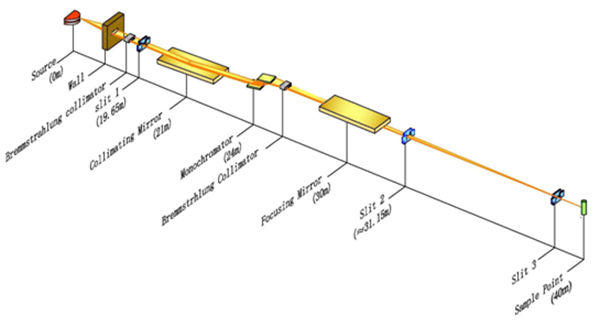
3. Techniques
High-resolution powder X-ray diffraction (HRXRD)
Grazing Incident X-ray diffraction (GIXRD)
Grazing Incident X-ray Small Angle Scattering (GISAXS)
X-ray Reflectivity measurement (XRR)
Reciprocal Space Mappings (RSM)
Polar Map
Diffraction anomalous fine structure (DAFS)
4. Optics
Collimating Mirror (Rh coated)
Sagittal double crystal monochromator ( Si(111) )
Focusing Mirror
5. Endstations
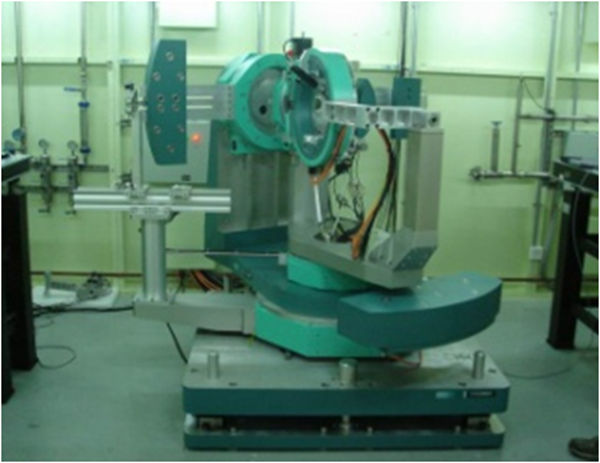
Huber 5021 6-circle diffractometer
NaI Scintillation detector
Ionization chamber
Fluorescence detector
Mar345
6. Beamline Specifications
|
Source |
Bending Magnet |
|
|
4-22 keV |
|
EnergyResolution(ΔE/E) |
≤2.0´10-4 |
|
Photon Flux at sample |
≥2´1011phs/s@10keV@300 mA |
|
Beam size at sample |
≤0.4´ |
|
Beam divergence (Focused) |
≤2.5´0.2 mrad2 |
7. Typical experiments
i) Powder diffraction
This method can be applied for the measurements of various samples, such as heterogeneous catalysts, compounds for hydrogen storage, electrodes materials for lithium battery applications, ferro-electric compounds, thermo-electric compounds, super-conductor materials, etc.
The main advantages for synchrotron-based powdered x-ray diffraction are the following: Monochromatic beam without Kα2 diffraction peaks normally observed in the conventional XRD systems. High photon flux with much higher signal to noise ratio. Highly collimated beam with much better angular resolution.
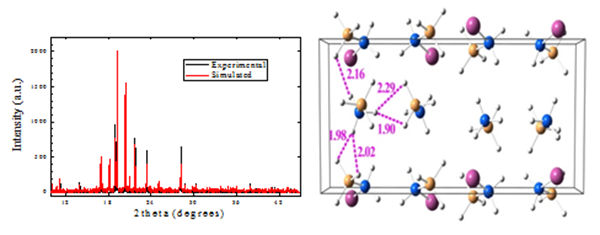
As an example, at BL14B1, Professor Chen Ping’s group (from Dalian Institute of Chemical Physics,
Ref: Wu, C. Z.; Wu, G. T.; Xiong, Z. T.; Han, X. W.; Chu, H. L.; He, T.; Chen, P. Chem. Mater. 2010, 22, 3-5.
ii) Epitaxially-grown thin films and organic thin films
There are a lot of users working with thin-films, which sometimes can be as thin as one atomic layer. For these samples, especially those thin films grown on single crystal substrates, grazing-incidence XRD is often used, which normally requires a very careful calibration of the 0 position of the theta angle. With a very small incidence angle, one expect to have much higher cross-section for detection, thus to increase the sample signal and greatly suppress the signal from the substrate.
Using the NaI point detector, there are two modes are available.
a) In-plane scan: One can fix the incidence angle (say 0.2 degrees), and scan the two theta arm horizontally and collect the in plane diffraction signal from the sample. This signal is essentially the diffraction signal from the sample, which displays long range ordering perpendicular to the sample surface.
b) Out of plane scan: One can collect the out of plane signal by scanning the two theta arm vertically. The sample signal, which displays long-range ordering parallel to the normal of the sample surface, can be studied.
c) Using 2-dimensional image plate detector, the above two modes (in plane and out of plane) can be further studied, after the incidence angle of the film is determined using the NaI detector.
Grazing-incidence X-ray diffraction can be applied widely in the field such as super-conductivity, ferro-electric thin film, thermo-electric thin film, semiconducting thin film, wet-epitaxially-grown organic film, polymer thin film transistors, etc.

As an example, Professor Peijian’s group from
Ref: Lei, T.; Cao, Y.; Fan , Y. L.; Liu, C. J.; Yuan, S. C.; Pei, J. J. Am. Chem. Soc. 2011,133, 6099-101.
Using the diffraction and reflection techniques, professor Wu Xiaoshan from Nanjing University, proves that their thin film is with a 1x1 Epitaxially-grown superlattice structure. Their studies also proves that a single SrRuO3 unit cell can be ferromagnetic, which greatly advanced the reported results. (Ferromagnetism can only exist with a structure more than 4 unit cells) Thus electrodes can be manufactured in a much thinner manner. Besides that, their studies also find that metal-insulator transition can take place in that 1x1 superlattice under strain adjustments. This strain regulation can also incur paramagnetism to ferromagetism transition. Part of their research has been published in the top journal of physics: Phy. Rev. Lett.

Ref: Gu, M. Q.; Xie, Q. Y.; Shen, X.; Xie, R. B.; Wang, J. L.; Tang, G.; Wu, D.; Zhang, G. P.; Wu, X. S. Phy. Rev. Lett. 2012, 109, 157003.
iii) Polymer samples, silk, carbon fiber, etc.
Polymer samples (thin film) usually have some preferred orientation and can be best studied using the image plate detector. At BL14B1, polymeric samples is usually measured in the following two modes,
a) Transmission mode. First, the sample is posed perpendicularly to the beam to collect the data (exposure time 60s); Second, the background data are collected without sample under exact the same conditions; Third, using the Fit2d code, the sample signals are obtained after the background subtracted. As an example, two typical figures before/after background subtraction of a sample in transmission mode are shown, which demonstrate much better sample signals obtained after background subtraction.

b) Reflection mode. For polymeric samples grown on a substrate, X-ray hardly penetrate through the sample. In such a case, the measurements have to be done in the reflection mode. First, the sample is posed parallelly to the beam, with the 0 point position calibrated by using NaI point detector; Second, with a fixed incidence angle, the NaI detector is moved to 90 degrees, andthe image plate detector is moved closely to the sample; Third, the data are collected (exposure time 60s); Fourth, the sample is replaced by an identical substrate without the film, then the 0 point position is calibrated using NaI detector; Fifth, with the incidence angle fixed, the NaI is moved to 90 degrees andthe image detector is moved forward; Sixth, data are collected with the same exposure time; Seventh, using the fit2d code, the substrate signal is subtracted. The displayed two figures show typical results before/after background subtraction of a sample in reflection mode with much better sample signal.

iv) Riciprocal Space mapping
At ambient temperature, BiFeO3 is multi-ferroic (Both Ferro-magnetic and Ferro-electric) It has wide applications in microelectronics. However, the structure of BiFeO3 thin film is greatly depended on the substrate. Professor Yang Ping (Singapore Light Source) successfully measured BiFeO3 thin films grown on different substrates at BL14B1, using reciprocal space mapping techniques. For sample of BiFeO3/LaAlO3 001(Left figure), the diffraction peak of (1 0 3) is a triplet, thus, it is a monoclinic Mc phase instead of the MA or MB phase reported by previous studies. The Polarization Rotation Path Mediated by Epitaxial Strain is showed in right Figure

Synchrotron XRD RSM for the fi lm on LAO near the
103 reflection of the tetragonal-like phase. Polarization Rotation Path Mediated by Epitaxial Strain
Ref: Chen, Z. H.; Luo, Z. L.; Huang, C. W.; Qi, Y. J.; Yang, P.; You, L.; Hu, C. S.; Wu, T.;
Wang, J. L.; Gao, C.; Sritharan, T.; Chen, L. Ad.v. Funct. Mater. 2011, 21, 133-138.
v) In situ studies.
One of the most prominent advantages of the synchrotron-based techniques is that it can provide very high photon flux, which is necessary for situ studies and not available using conventional XRD facilities. The in situ experiments can provide real time studies of the sample at non-ambient condition, which otherwise might change. For the in situ experiments, we have a high temperature chamber. Now it is mainly used either with inert gas environment or under vacuum condition. The heating is carried out using a direct Mo strip heater with a temperature of 800
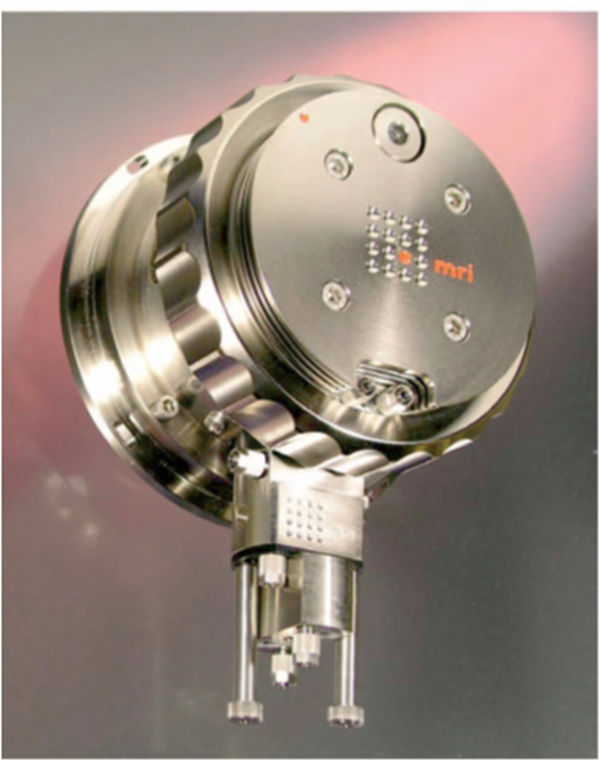
As an example, in situ study of In2Se3 will be shown in the following, which has wide applications in data storage, solar cells, sensors and lithium ion batteries. Typically, it has 4 phases and are α, β, γ, δ. New phase of κ phase could also exist after doping. At beamline BL14B1, Professor Sun Xuhui from Suchoo University investigated the phase transitions of In2Se3. Around
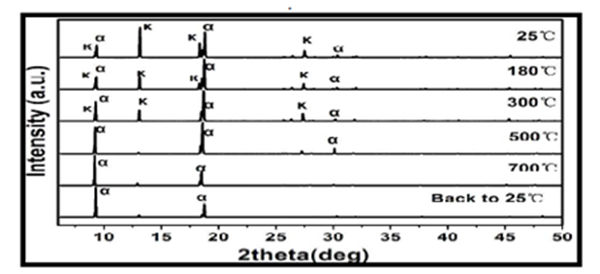
Ref: Li, Y.; Gao, J.; Li, Q. L.; Peng, M. F.; Sun, X. H.; Li, Y. Y.; Yuan, G.; Wen, W.; Meyyappan, M. J. Mater. Chem. 2011, 21, 6944.
Biomass combustion tends to cause atmospheric pollution by generating nano-particles (PM2.5) and NOx. One effective solution is to convert them to heat energy or electricity through combustion in a furnace. Aerosol produced by the combustion process, however, has high alkali concentration, which will deactivate catalyst consequently. Recent research of Professor Tang Xingfu’s group (

8. Contacts
Wen Wen wenwen@sinap.ac.cn +86-21-33933215
Yang Tie Ying yangtieying@sinap.ac.cn +86-21-33932091


 Copyright©2006.12 Shanghai Advanced Research Institute.
Copyright©2006.12 Shanghai Advanced Research Institute.